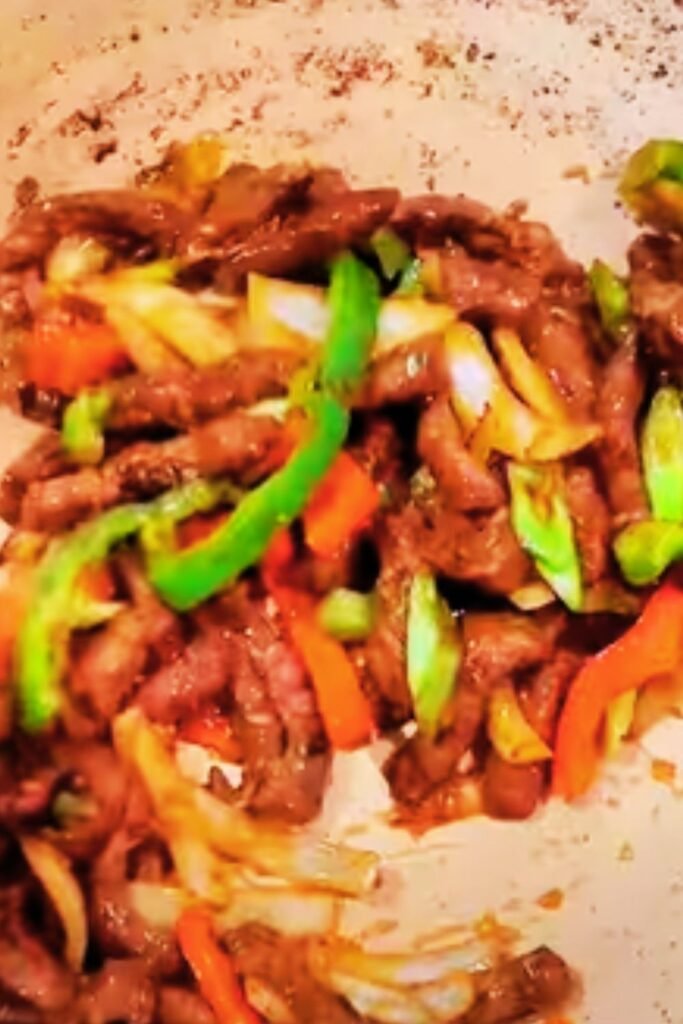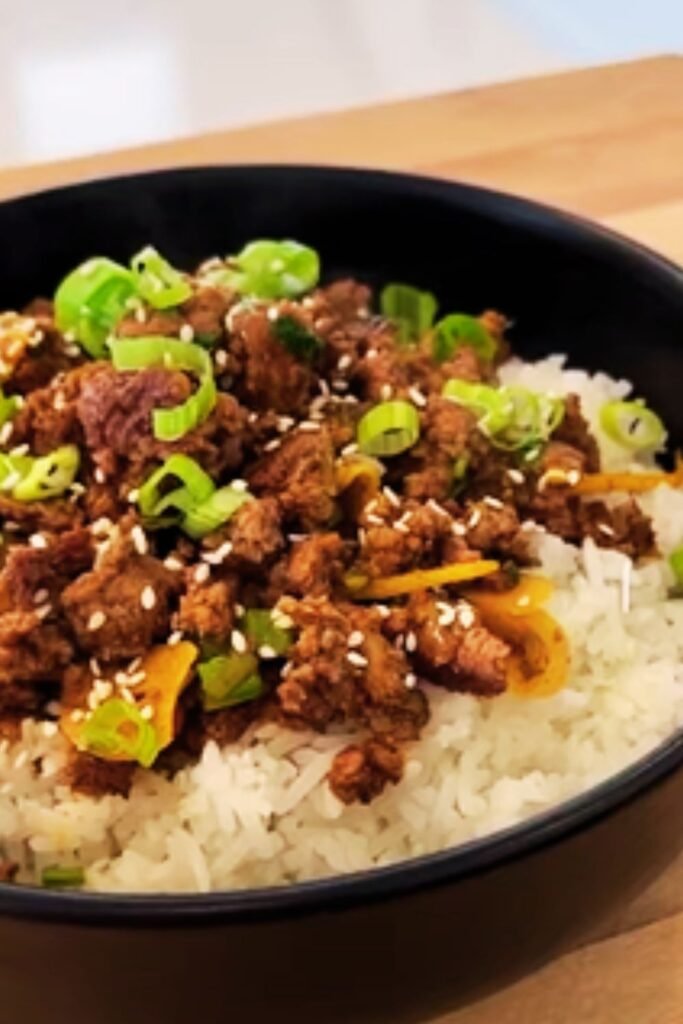There’s something magical about that first bite of crispy ginger beef – the perfect balance of sweet and savory flavors, the satisfying crunch giving way to tender meat, and that delightful kick of ginger and chili. I’ve spent years perfecting this recipe, and today I’m sharing all my secrets to help you create restaurant-quality crispy ginger beef right in your own kitchen.
Growing up in a family that celebrated food, I learned early on that certain dishes have the power to transform an ordinary meal into something memorable. Crispy ginger beef is definitely one of those dishes. While it’s a staple on Chinese-Canadian restaurant menus, making it at home allows you to adjust the flavors to your preference and ensure the beef achieves that perfect texture – crispy on the outside, tender on the inside.
What Makes This Recipe Special
This isn’t just any crispy ginger beef recipe. I’ve refined this over countless attempts, taking notes from professional chefs and incorporating techniques that deliver consistent results every time. The beef is sliced paper-thin to ensure maximum crispiness. The batter is light yet sturdy enough to hold up to the sauce. And the sauce itself? It’s a perfect harmony of sweet, savory, tangy, and spicy elements that will have you licking your plate clean.
Let me walk you through creating this incredible dish step by step.
Ingredients
For the Beef and Batter
- 1 pound flank steak (or sirloin), partially frozen for easier slicing
- 2 eggs, beaten
- 1/4 cup cornstarch
- 1/4 cup all-purpose flour
- 1 teaspoon baking powder
- 1/2 teaspoon salt
- 1/4 teaspoon white pepper
- Vegetable oil for deep frying (about 3 cups)
For the Sauce
- 1/4 cup soy sauce (low sodium preferred)
- 3 tablespoons rice vinegar
- 3 tablespoons brown sugar
- 2 tablespoons honey
- 2 tablespoons fresh ginger, finely minced
- 4 cloves garlic, minced
- 2-3 dried red chilies, seeded and chopped (adjust to taste)
- 1 teaspoon sesame oil
- 1 tablespoon cornstarch dissolved in 2 tablespoons water
For the Vegetables and Garnish
- 1 red bell pepper, thinly sliced
- 1 carrot, julienned
- 4 green onions, cut into 2-inch lengths (plus extra, thinly sliced for garnish)
- 2 tablespoons fresh ginger, cut into thin matchsticks
- 1 tablespoon toasted sesame seeds
- Fresh cilantro leaves (optional)
Equipment You’ll Need

- Sharp knife (the sharper the better for thin slicing)
- Large wok or deep frying pan
- Thermometer for oil temperature (if available)
- Paper towels for draining
- Mixing bowls
- Slotted spoon or spider strainer
- Small saucepan for the sauce
Preparation Steps
Step 1: Prepare the Beef
The secret to truly crispy ginger beef starts with how you prepare the meat. Here’s my foolproof method:
- Place the flank steak in the freezer for about 30 minutes until it’s partially frozen. This makes it much easier to slice thinly.
- Remove the steak from the freezer and slice against the grain into very thin strips, about 1/8-inch thick and 2-3 inches long.
- Pat the beef strips dry with paper towels. This is crucial for achieving maximum crispiness.
- Place the beef strips in a bowl and set aside while you prepare the batter.
Step 2: Make the Batter
The batter is what gives our beef its signature crunch. Here’s how to get it just right:
- In a medium bowl, whisk together the cornstarch, flour, baking powder, salt, and white pepper.
- Add the beaten eggs and stir until you have a smooth, slightly thick batter. It should coat the back of a spoon but still be fluid enough to easily coat the beef.
- If the batter seems too thick, add a tablespoon of cold water at a time until you reach the desired consistency.
Step 3: Prepare the Sauce
A great sauce makes all the difference. Let’s create a balanced blend of flavors:
- In a small saucepan, combine the soy sauce, rice vinegar, brown sugar, and honey.
- Add the minced ginger, garlic, and chopped dried chilies.
- Bring the mixture to a gentle simmer over medium heat.
- Once simmering, stir in the sesame oil.
- In a small bowl, mix the cornstarch with water to create a slurry.
- Slowly pour the slurry into the simmering sauce, stirring constantly.
- Continue to cook, stirring, until the sauce thickens enough to coat the back of a spoon, about 2-3 minutes.
- Remove from heat and set aside.
Step 4: Fry the Beef
This is where the magic happens – transforming those beef strips into crispy, golden delights:
- Heat the vegetable oil in your wok or deep frying pan to 375°F (190°C). If you don’t have a thermometer, test the oil by dropping a small amount of batter into it – it should sizzle immediately and rise to the surface.
- Working in batches to avoid overcrowding, dip the beef strips into the batter to coat completely.
- Carefully add the battered beef strips to the hot oil, one by one.
- Fry for 2-3 minutes until golden brown and crispy.
- Using a slotted spoon or spider strainer, remove the crispy beef and drain on paper towels.
- Repeat with the remaining beef strips, maintaining the oil temperature between batches.
Step 5: Stir-Fry the Vegetables
Now let’s add some color and texture:
- Pour off all but 2 tablespoons of oil from the wok.
- Heat the wok over high heat until it’s smoking slightly.
- Add the ginger matchsticks and stir-fry for 30 seconds until fragrant.
- Add the red bell pepper and carrot, stir-frying for 1-2 minutes until slightly softened but still crisp.
- Toss in the green onion lengths and stir-fry for another 30 seconds.
Step 6: Bring It All Together
The final assembly creates a harmonious dish where every element shines:
- Return the crispy beef to the wok with the vegetables.
- Pour the prepared sauce over everything.
- Toss quickly but gently to coat all the beef and vegetables with sauce, being careful not to break the crispy coating on the beef (about 30 seconds to 1 minute).
- Remove from heat immediately once everything is coated to preserve the crispiness.
Serving Suggestions

Transfer your crispy ginger beef to a large serving platter, garnishing with:
- Thinly sliced green onions
- Toasted sesame seeds
- Fresh cilantro leaves
For a complete meal, I love serving this with:
- Steamed jasmine rice or coconut rice
- Simple stir-fried bok choy or chinese broccoli
- Hot and sour soup as a starter
- Fresh cucumber salad with rice vinegar dressing
- Sparkling water with lemon or lime
- Jasmine or oolong tea
Storage and Reheating Tips
While crispy ginger beef is best enjoyed immediately after cooking (that’s when the texture is absolutely perfect), here’s how to handle leftovers:
Storage:
- Refrigerate in an airtight container for up to 2 days.
- Keep the sauce separate from any unused crispy beef if possible.
Reheating:
- For the best texture, reheat in a 375°F (190°C) oven for 5-7 minutes.
- Avoid microwaving if possible, as it will make the beef soggy.
- If you stored beef and sauce separately, only combine after reheating the beef.
Common Problems and Solutions
| Problem | Cause | Solution |
|---|---|---|
| Beef isn’t crispy enough | Oil temperature too low | Use a thermometer to maintain 375°F oil temperature |
| Beef not dry before battering | Pat beef strips thoroughly dry with paper towels | |
| Sauce added too soon | Ensure beef is well-drained and toss with sauce just before serving | |
| Beef is tough or chewy | Sliced too thick | Partially freeze beef for easier thin slicing |
| Cut with the grain instead of against | Always slice against the grain for tenderness | |
| Overcooked | Fry only until golden brown, about 2-3 minutes | |
| Sauce is too thin | Not enough cornstarch | Add more cornstarch slurry, 1 teaspoon at a time |
| Not cooked long enough | Simmer until it coats the back of a spoon | |
| Sauce is too thick | Too much cornstarch | Thin with a little water or stock |
| Batter falls off during frying | Oil not hot enough | Ensure oil is at proper temperature before adding beef |
| Beef too wet before battering | Pat beef strips thoroughly dry | |
| Overcrowding the pan | Fry in smaller batches |
Nutritional Information
| Nutrient | Amount per Serving |
|---|---|
| Calories | 420 |
| Protein | 28g |
| Carbohydrates | 32g |
| Dietary Fiber | 2g |
| Sugars | 18g |
| Fat | 22g |
| Saturated Fat | 5g |
| Sodium | 890mg |
| Potassium | 480mg |
| Iron | 15% DV |
| Vitamin C | 45% DV |
| Vitamin A | 35% DV |
*Values are approximate and based on 4 servings.
Variations to Try

Once you’ve mastered the basic recipe, here are some creative variations to explore:
Spicy Szechuan Style
- Double the dried chilies
- Add 1 tablespoon of Szechuan peppercorns (toasted and ground)
- Include 1-2 tablespoons of chili oil in the sauce
Orange Ginger Beef
- Add the zest and juice of one orange to the sauce
- Reduce the vinegar by half
- Include 1/4 teaspoon of five-spice powder
Honey Garlic Ginger Beef
- Double the honey in the sauce
- Add 2-3 more cloves of garlic
- Include 1 tablespoon of hoisin sauce
Vegetable-Loaded Version
- Add broccoli florets, snap peas, and water chestnuts
- Increase the sauce quantity by 50%
- Stir-fry vegetables slightly longer until tender-crisp
Expert Tips for Perfect Crispy Ginger Beef
After years of making this dish, I’ve discovered some game-changing tips that make all the difference:
- The freeze technique: Partially freezing the beef for about 30 minutes makes it much easier to slice ultra-thin.
- Double-fry method: For extra crispy beef, try frying the beef twice: once at 325°F (165°C) for 2 minutes, then again at 375°F (190°C) for 1 minute after resting.
- Cornstarch magic: Adding a bit of cornstarch to the beef before dipping in batter creates an even crispier texture.
- Rice vinegar substitute: If you don’t have rice vinegar, apple cider vinegar with a pinch of sugar works in a pinch.
- Ginger freshness test: When buying ginger, look for firm pieces with smooth skin. It should smell fresh and spicy when you scratch the surface slightly.
- Oil temperature consistency: Keep a close eye on your oil temperature between batches. If it drops too low, wait until it returns to 375°F before adding more beef.
- Quick toss: When combining the beef with sauce, do it quickly and off the heat to preserve crispiness.
The History Behind the Dish
Crispy ginger beef is actually a fascinating culinary creation with roots in Chinese-Canadian cuisine. The dish as we know it today was popularized in Calgary, Alberta in the 1970s, created by Chef George Wong at the Silver Inn Restaurant. It represents a beautiful fusion of traditional Chinese cooking techniques with Western ingredients and taste preferences.
The original dish was developed to appeal to Canadian palates while using authentic Chinese cooking methods. Traditional Chinese cuisine often features beef in stir-fries, but the crispy battered version with a sweet-savory sauce was an innovation that quickly became a North American favorite.
What I find most fascinating is how dishes like this evolve across cultures, creating something entirely new that honors its origins while embracing local tastes. When you make this recipe, you’re participating in this wonderful culinary exchange!
Frequently Asked Questions

Q: What’s the best cut of beef to use for crispy ginger beef?
A: Flank steak is my top choice because it has the perfect balance of lean meat and marbling. Sirloin also works well. The key is choosing a cut that can be sliced very thinly against the grain. Avoid cuts that are too lean as they can become tough when fried.
Q: Can I make this dish gluten-free?
A: Absolutely! Replace the all-purpose flour with rice flour or a gluten-free flour blend, and use tamari or certified gluten-free soy sauce. Double-check that your cornstarch is processed in a gluten-free facility.
Q: How spicy is this recipe? Can I adjust the heat level?
A: As written, this recipe has a moderate heat level. To make it milder, reduce or omit the dried chilies. For extra heat, increase the dried chilies or add fresh sliced chilies to the stir-fry, or include a teaspoon of chili oil or sriracha in the sauce.
Q: Can I prepare any components ahead of time?
A: Yes! You can slice the beef and prepare the sauce up to 24 hours in advance. Store both in separate containers in the refrigerator. The vegetables can be sliced a few hours ahead. However, for best results, the battering and frying should be done just before serving.
Q: Is there a way to make this healthier?
A: For a lighter version, you can shallow-fry the beef instead of deep-frying, using about 1/4 inch of oil in a pan. You can also reduce the sugar in the sauce by half and increase the vegetables. For a lower-carb option, serve with cauliflower rice instead of regular rice.
Q: Can I use pre-sliced beef from the grocery store?
A: While convenient, pre-sliced beef is usually not thin enough for this recipe. I strongly recommend slicing it yourself from a partially frozen piece of flank steak or sirloin to get those signature thin strips that crisp up perfectly.
Q: What if I don’t have a wok?
A: A large, deep frying pan works fine for this recipe. The key is having enough space and depth for safe frying. For the stir-fry portion, any wide pan with high sides will do the job nicely.
Q: Can I air-fry the beef instead of deep-frying?
A: While not traditional, you can adapt this for an air fryer. Spray the battered beef strips with cooking oil before air-frying at 400°F for about 8 minutes, turning halfway through. The texture won’t be exactly the same as deep-fried, but it’s a good alternative for those looking to use less oil.
Final Thoughts
Creating restaurant-quality crispy ginger beef at home might seem intimidating at first, but with these detailed steps and tips, you’ll be surprised at how achievable it is. The combination of crispy, tender beef with the aromatic ginger-garlic sauce creates a dish that’s sure to impress family and friends alike.
What I love most about this recipe is how it balances textures and flavors – the crunch of the beef against the crisp-tender vegetables, the sweetness of the sauce countered by the warmth of ginger and chili. It’s a sensory experience that makes everyday meals feel special.
Don’t be discouraged if your first attempt isn’t perfect. Like any cooking technique, achieving that perfect crispy coating takes practice. Each time you make it, you’ll get more comfortable with the process and can start adding your own creative touches.
I hope this recipe brings as much joy to your table as it has to mine over the years. There’s something deeply satisfying about mastering a restaurant favorite in your own kitchen. So heat up that oil, slice that beef paper-thin, and get ready to create some culinary magic!


